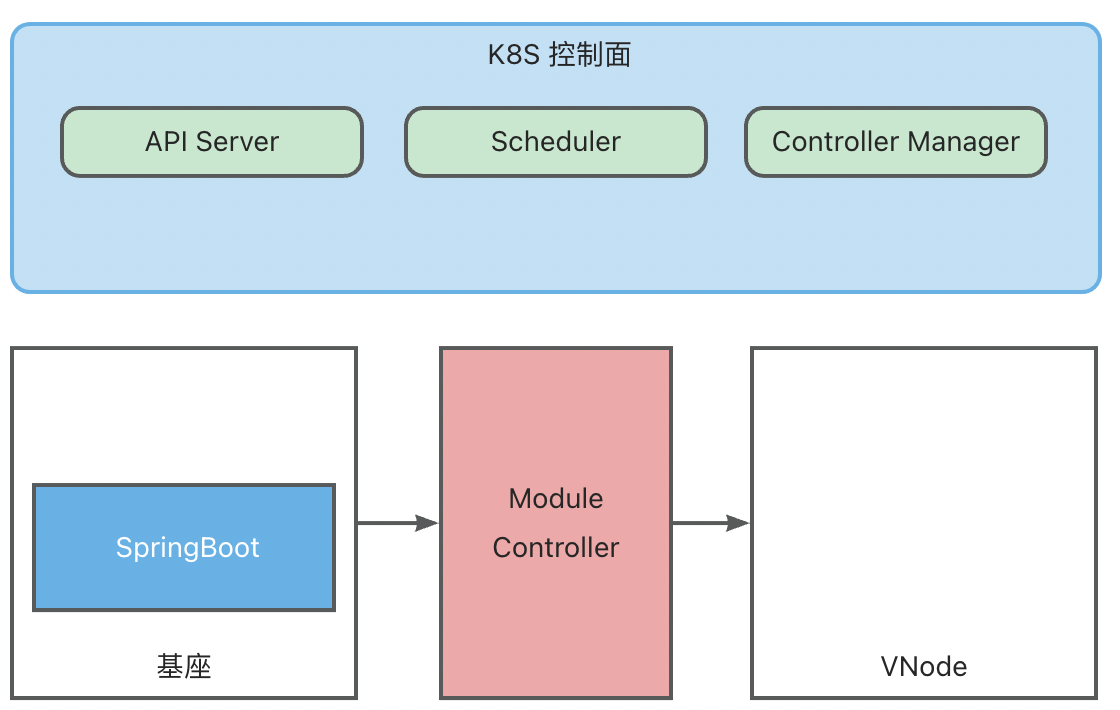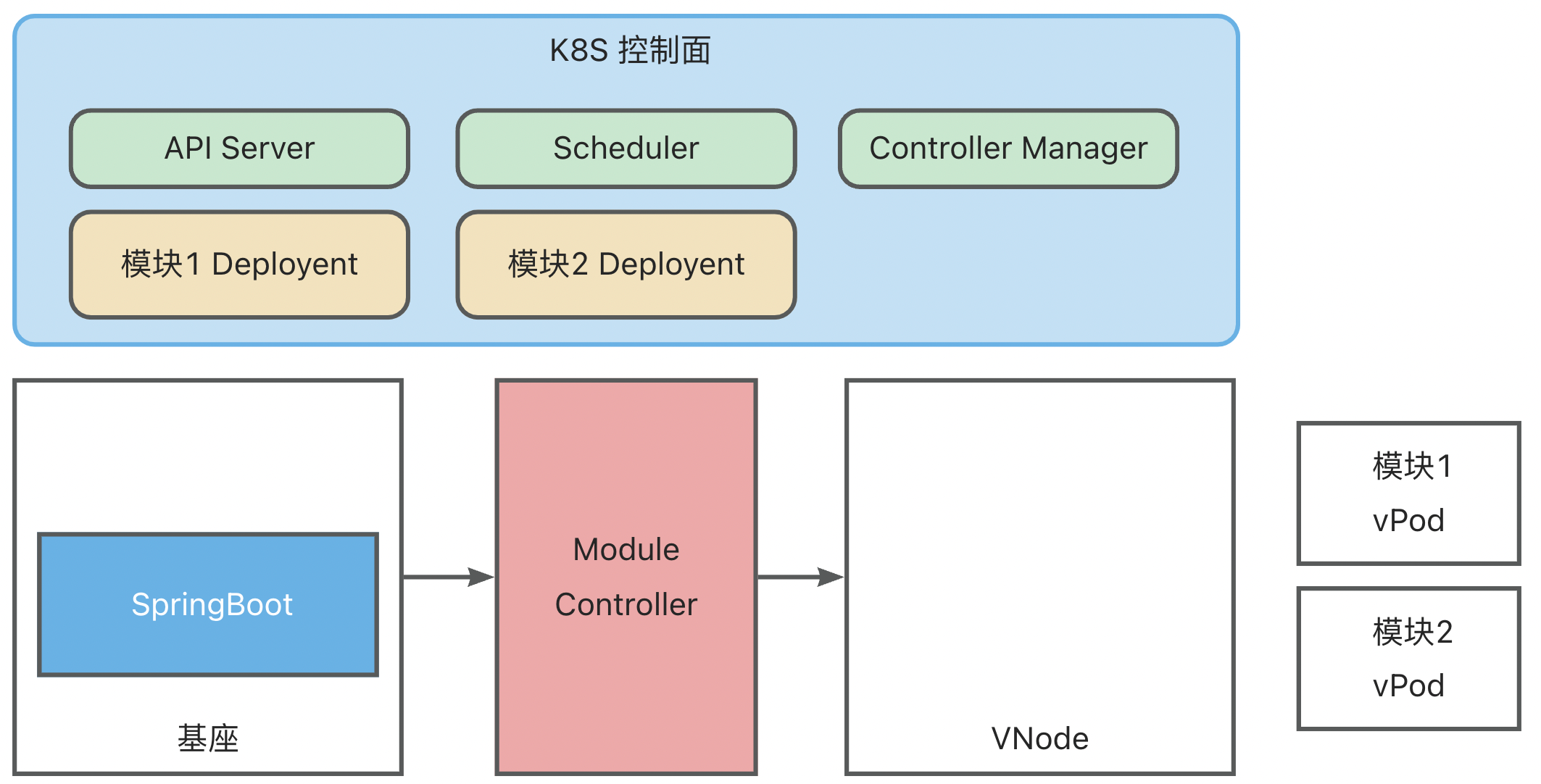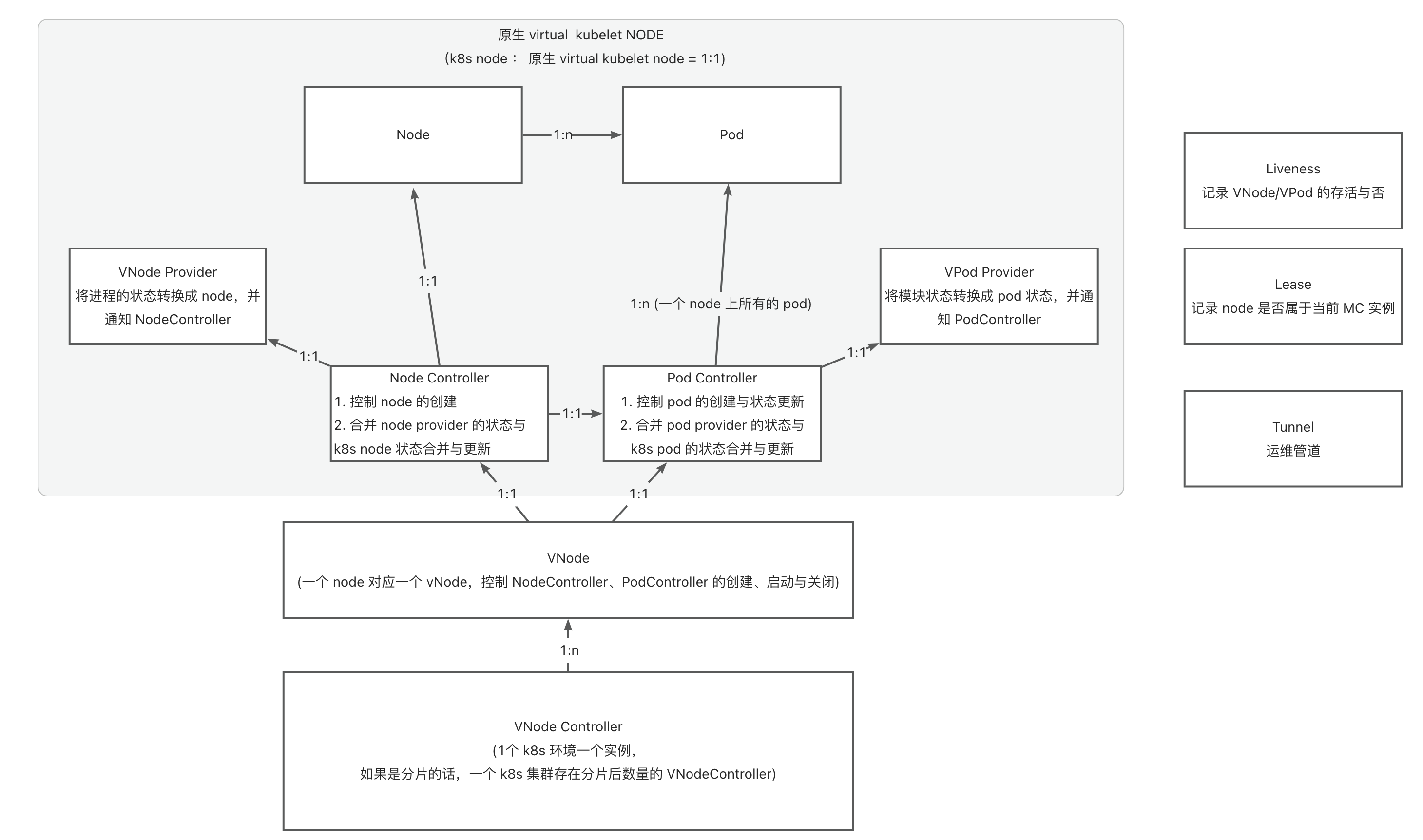6.6.2 ModuleControllerV2 Scheduling Principles
Brief Introduction
Module Controller V2 leverages the multi-tenant capabilities of Virtual Kubelet to map bases as Nodes in K8S. By defining modules as Pods, it reuses the K8S scheduler and various controllers to quickly build module operation and scheduling capabilities.

Base <-> VNode Mapping
Module Controller V2 implements base discovery through Tunnel, mapping it as a Node via Virtual Kubelet. Such Nodes are referred to as VNodes.
Upon base discovery, the configured Metadata and Network information are read. Metadata includes Name and Version, while Network includes IP and Hostname.
Metadata becomes Label information on the VNode to identify base details. Network information becomes the VNode’s network configuration. Future module pods scheduled onto the base will inherit the VNode’s IP for configuring Services, etc.
A VNode will also contain the following key information:
apiVersion: v1
kind: Node
metadata:
labels:
virtual-kubelet.koupleless.io/component: vnode # vnode marker
virtual-kubelet.koupleless.io/env: dev # vnode environment marker
base.koupleless.io/name: base # Name from base Metadata configuration
vnode.koupleless.io/tunnel: mqtt_tunnel_provider # Current tunnel ownership of the base
base.koupleless.io/version: 1.0.0 # Base version number
name: vnode.2ce92dca-032e-4956-bc91-27b43406dad2 # vnode name, latter part is UUID from the base maintenance pipeline
spec:
taints:
- effect: NoExecute
key: schedule.koupleless.io/virtual-node # vnode taint to prevent regular pod scheduling
value: "True"
- effect: NoExecute
key: schedule.koupleless.io/node-env # node env taint to prevent non-current environment pod scheduling
value: dev
status:
addresses:
- address: 127.0.0.1
type: InternalIP
- address: local
type: Hostname
Module <-> Pod Mapping
Module Controller V2 defines a module as a Pod in the K8S system, allowing for rich scheduling capabilities through Pod YAML configuration.
A module Pod YAML configuration is as follows:
apiVersion: v1
kind: Pod
metadata:
name: test-single-module-biz1
labels:
virtual-kubelet.koupleless.io/component: module # Necessary to declare pod type for module controller management
spec:
containers:
- name: biz1 # Module name, must strictly match the artifactId in the module's pom
image: https://serverless-opensource.oss-cn-shanghai.aliyuncs.com/module-packages/stable/biz1-web-single-host-0.0.1-SNAPSHOT-ark-biz.jar # jar package address, supports local file, http/https link
env:
- name: BIZ_VERSION # Module version configuration
value: 0.0.1-SNAPSHOT # Must strictly match the version in the pom
affinity:
nodeAffinity:
requiredDuringSchedulingIgnoredDuringExecution:
nodeSelectorTerms: # Base node selection
- matchExpressions:
- key: base.koupleless.io/version # Base version filtering
operator: In
values:
- 1.0.0 # Module may only be schedulable to certain versions of bases; if restricted, this field is required.
- key: base.koupleless.io/name # Base name filtering
operator: In
values:
- base # Module may only be schedulable to certain specific bases; if restricted, this field is required.
tolerations:
- key: "schedule.koupleless.io/virtual-node" # Ensure the module can be scheduled onto a base vnode
operator: "Equal"
value: "True"
effect: "NoExecute"
- key: "schedule.koupleless.io/node-env" # Ensure the module can be scheduled onto a base node in a specific environment
operator: "Equal"
value: "test"
effect: "NoExecute"
The above example shows only the basic configuration. Additional configurations can be added to achieve richer scheduling capabilities, such as adding Pod AntiAffinity in Module Deployment scenarios to prevent duplicate module installations.
Operations Workflow
Based on the above structure and mapping relationships, we can leverage Kubernetes (K8S) native control plane components to fulfill diverse and complex module operation requirements.
The following illustrates the entire module operations workflow using the Deployment module as an example, with the base already initialized and mapped:

- Create the Module Deployment (a native K8S Deployment, where the PodSpec within the Template defines module information). The Deployment Controller in the K8S ControllerManager will create a virtual Pod (vPod) according to the Deployment configuration. At this point, the vPod wasn’t scheduled,with a status of Pending.

- K8S Scheduler scans unscheduled vPods and schedules them onto appropriate virtual Nodes (vNodes) based on selector, affinity, taint/toleration configurations.

- Upon detecting the completion of vPod scheduling, the Module Controller retrieves the module information defined within the vPod and sends installation commands to the base.

After the base completes the module installation, it synchronizes the module installation status with the Module Controller, which then translates the module status into Container Status and syncs it with Kubernetes.
Concurrently, the base continuously reports its health status. The Module Controller maps Metaspace capacity and usage to Node Memory, updating this information in Kubernetes.
Implementation Logic
The core logic involved in the implementation is as follows:

Model definition and logical relationships:

how to debug
- start module-controller test version in minikube,
serverless-registry.cn-shanghai.cr.aliyuncs.com/opensource/test/module-controller-v2:v2.1.4, the image has been configured with go-delve remote debug environment, debug port is 2345
apiVersion: apps/v1
kind: Deployment
metadata:
name: module-controller
spec:
replicas: 1
selector:
matchLabels:
app: module-controller
template:
metadata:
labels:
app: module-controller
spec:
serviceAccountName: virtual-kubelet # 上一步中配置好的 Service Account
containers:
- name: module-controller
image: serverless-registry.cn-shanghai.cr.aliyuncs.com/opensource/test/module-controller-v2:v2.1.4 # 已经打包好的镜像,镜像在 Module-controller 根目录的 debug.Dockerfile
imagePullPolicy: Always
resources:
limits:
cpu: "1000m"
memory: "400Mi"
ports:
- name: httptunnel
containerPort: 7777
- name: debug
containerPort: 2345
env:
- name: ENABLE_HTTP_TUNNEL
value: "true"
- Log in to the started container
kubectl exec module-controller-544c965c78-mp758 -it -- /bin/sh
- Enter the container and start delve
dlv --listen=:2345 --headless=true --api-version=2 --accept-multiclient exec ./module_controller
- Exit the container and set up port forwarding for port 2345
kubectl port-forward module-controller-76bdbcdd8d-fhvfd 2345:2345
- Start remote debugging in Goland or IDEA, with Host as
localhostand Port as2345.
Feedback
Was this page helpful?
Welcome propose feedback to community!
Welcome propose feedback to community, or improve this document directly.。